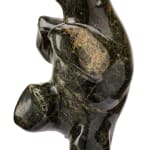-
Artworks
PAUTA SAILA, R.C.A. (1916-2009) KINNGAIT (CAPE DORSET)
Dancing Bear, c. 1983stone and antler, 22.5 x 12.75 x 12.5 in (57.1 x 32.4 x 31.8 cm)
signed, "PAOTA SAILA";
signed again, "ᐸᐅᑕ / ᓴᐃᓚ".
LOT 89
ESTIMATE: $50,000 — $80,000
PRICE REALIZED: $52,800.00Further images
My father was a very good carver; he was better than me. If he carved an ookpik [owl] or a man or a woman, it was done perfectly. It was...My father was a very good carver; he was better than me. If he carved an ookpik [owl] or a man or a woman, it was done perfectly. It was completely real [1]. Pauta Saila emulated his father in artmaking as he did in so many other aspects of life. I started carving as a child. My father was a carver, so I started young. I carved small ivory pieces [2].
Pauta may have tried to emulate his father’s carving style as a child, but today he is celebrated as one of the truly great Inuit sculptors, an artist who invented a whole new way of imagining and carving polar bears. It is Pauta’s unique vision and style that are emulated by generations of carvers.
I’ve never taken any pictures, it just stayed in my memory when I saw polar bears dancing…. When I was a child I used to look at the bears before my father started going after them….I love watching bears - the way they move [3].
Pauta’s abiding love and respect for the animal shines forth in this masterful Dancing Bear from c. 1983. It is one of several monumental and imposing bears the artist carved in the early 1980s. Dancing Bear in the Sarick Collection at the AGO comes to mind (Hessel, Inuit Art, fig. 102 and front cover), but we are particularly reminded of a slightly smaller but very similarly posed and proportioned example from c. 1985 (Walker’s Auctions, Ottawa, November 2017, Lot 62), and an equally large Dancing Bear from 1984 (Walker’s Auctions, Ottawa, May 2012, Lot 24).
Dancing Bear is impressively tall to begin with, but its generous proportions lend this example an especially monumental quality. With its glossy, massive limbs seemingly poised for combat and its mouth open in an almost audible roar, this bear strikes us as a particularly powerful and ferocious-looking example. And as with the best versions of this theme by Pauta, Dancing Bear is a commanding and dramatic sculpture when viewed from any angle.
1. From an interview with Dorothy Harley Eber, in “Talking with the Artists” in In the Shadow of the Sun (Gatineau: Canadian Museum of Civilization, 1993), pp. 433-434.
2. From a 2004 interview with Ingo Hessel, in Arctic Spirit, (Vancouver: Douglas & McIntyre / Phoenix: Heard Museum, 2006), p. 90.
3. Loc. cit.
References: For similarly large and important examples by the artist, see Ingo Hessel, Inuit Art: An Introduction, (Douglas & McIntyre, 1998) cover and fig. 102; from 1984 in the Sarick Collection, Art Gallery of Ontario (also illus. in Gerald McMaster, ed., Inuit Modern: The Samuel and Esther Sarick Collection, (Toronto: Art Gallery of Ontario, 2010), p. 116; Bernadette Driscoll, Uumajut: Animal Imagery in Inuit, (Winnipeg: Winnipeg Art Gallery, 1985), cat. 1; TD Bank Collection (also illus. in Canadian Eskimo Arts Council, Sculpture / Inuit: Masterworks of the Canadian Arctic, (Toronto: University of Toronto Press, 1971), fig. 158); Susan Gustavison, Northern Rock: Contemporary Inuit Stone Sculpture, (Kleinburg: McMichael Canadian Art Collection, 1999) cat. 8. See also Marion Scott Gallery, Inspiration (1996) cat. 23. See also Walker's Auctions, Ottawa, 22 November 2017, Lot 62; 13 May 2013, Lot 15; 3 May 2012, Lot 24. See Waddington's Auctions, Toronto, 30 May 2016, Lot 40; 23 April 2007, Lot 79.Provenance
Private Collection, Toronto.
Join our mailing list
* denotes required fields
We will process the personal data you have supplied in accordance with our privacy policy (available on request). You can unsubscribe or change your preferences at any time by clicking the link in our emails.














